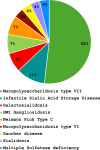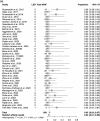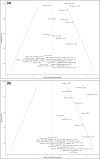Lysosomal storage disorders in nonimmune hydrops fetalis diagnosed by exome sequencing
- PMID: 40640912
- PMCID: PMC12243238
- DOI: 10.1186/s13023-025-03851-9
Lysosomal storage disorders in nonimmune hydrops fetalis diagnosed by exome sequencing
Abstract
Lysosomal storage disorders (LSD) are a group of inherited metabolic diseases that contribute to nonimmune hydrops fetalis (NIHF). Our objective was to review the pooled exome sequencing (ES) diagnostic yield of LSD in NIHF cases. We expanded our previous meta-analysis and updated our search strategy of prenatal ES studies from 1/1/2000 to 8/1/2024. Cases with LSD gene variants were reviewed. Variants were curated based on the current American College of Medical Genetics and Genomics and ClinGen guidelines. Forty-one ES studies met our inclusion criteria. A total of 207/558 NIHF cases yielded a positive diagnosis by ES. LSD cases represented 27/558 (5%) of all clinically diagnosed NIHF cases that had ES. Rate of LSD among NIHF cases with positive genetic diagnosis by ES was 27/207 (13%). The 27 diagnostic variants and 4 additional variants of uncertain significance (VUS) were identified in 9 different LSD genes. All variants were inherited with a recurrence risk of 25%. Mucopolysaccharidosis type VII (MPS VII) was most prevalent (14/27, 52%). Also, the 4 cases with VUS were identified in the GUSB gene. Most cases (21/31, 68%) were isolated NIHF. Hydrops recurrence when reported was present in 75% (15/20) of cases. Consanguinity was reported in 57% (12/21) of cases. In conclusion, 5% of all NIHF cases received a genetic diagnosis of LSD by ES. Thirteen percent of NIHF cases that received a genetic diagnosis by ES were attributable to LSD, with MPS VII being the most prevalent condition. Pairing ES results with enzymatic studies can aid variant interpretation and could have potentially upgraded some of the 4 VUS cases, leading to a higher LSD diagnostic yield. Most cases of LSD presenting as NIHF manifest prenatally as isolated NIHF. High rate of NIHF recurrence and consanguinity highlight importance of genetic counseling and testing for LSD.
Keywords: Exome; Hydrops fetalis; Lysosomal storage disorders.
© 2025. The Author(s).
Conflict of interest statement
Declarations. Ethics approval and consent to participate: Not applicable. Consent for publication: Not applicable. Competing interest: The authors declare that they have no competing interests. PROSPERO registration number: CRD42022369438. Previous presentation: Accepted as a poster presentation at the Society of Maternal Fetal Medicine 43rd Annual Pregnancy Meeting, San Francisco, February 2023.
Figures





Similar articles
-
RASopathies are the most common set of monogenic syndromes identified by exome sequencing for nonimmune hydrops fetalis: A systematic review and meta-analysis.Am J Med Genet A. 2024 May;194(5):e63494. doi: 10.1002/ajmg.a.63494. Epub 2023 Dec 29. Am J Med Genet A. 2024. PMID: 38156365
-
Genetic etiologies associated with non-immune hydrops fetalis delineated by whole exome sequencing: A pilot series and its implications in prenatal genetic counseling.J Obstet Gynaecol Res. 2025 Aug;51(8):e70039. doi: 10.1111/jog.70039. J Obstet Gynaecol Res. 2025. PMID: 40789765
-
Diagnostic yield from prenatal exome sequencing for non-immune hydrops fetalis: A systematic review and meta-analysis.Clin Genet. 2023 May;103(5):503-512. doi: 10.1111/cge.14309. Epub 2023 Feb 26. Clin Genet. 2023. PMID: 36757664
-
Lysosomal storage disease as an etiology of nonimmune hydrops.Am J Obstet Gynecol. 2015 Mar;212(3):281-90. doi: 10.1016/j.ajog.2014.10.007. Epub 2014 Oct 8. Am J Obstet Gynecol. 2015. PMID: 25305402
-
Genetic diseases underlying a spectrum of fetal effusions.Am J Obstet Gynecol. 2025 May 8:S0002-9378(25)00304-7. doi: 10.1016/j.ajog.2025.04.072. Online ahead of print. Am J Obstet Gynecol. 2025. PMID: 40348118 Free PMC article.
References
-
- Norton ME, Chauhan SP, Dashe JS. Society for maternal-fetal medicine (SMFM) clinical guideline #7: nonimmune hydrops fetalis. Am J Obstet Gynecol. 2015;212(2):127–39. - PubMed
-
- Whybra C, Källén K, Hansson SR, Gunnarsson R. Non-immune hydrops fetalis was rare in Sweden during 1997–2015, but cases were associated with complications and poor prognosis. Acta Paediatr. 2020;109(12):2570–7. 10.1111/apa.15260. - PubMed
-
- Santolaya J, Alley D, Jaffe R, Warsof SL. Antenatal classification of hydrops fetalis. Obstet Gynecol. 1992;79(2):256–9. - PubMed
-
- Al-Kouatly HB, Shivashankar K, Mossayebi MH, Makhamreh M, Critchlow E, Gao Z, Fasehun LK, Alkuraya FS, Ryan EE, Hegde M, Wodoslawsky S, Hughes J, Berger SI. Diagnostic yield from prenatal exome sequencing for non-immune hydrops fetalis: a systematic review and meta-analysis. Clin Genet. 2023;103(5):503–12. 10.1111/cge.14309. - PubMed
Publication types
MeSH terms
LinkOut - more resources
Full Text Sources
Miscellaneous

